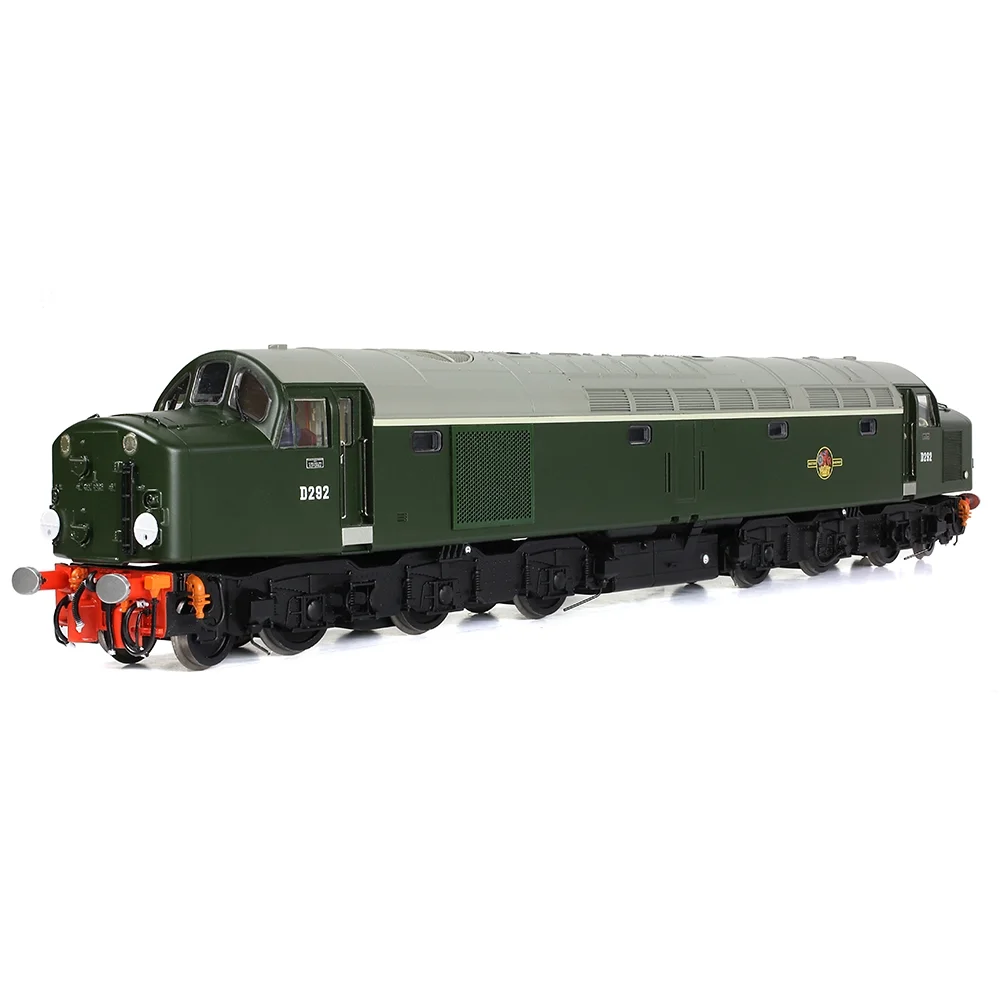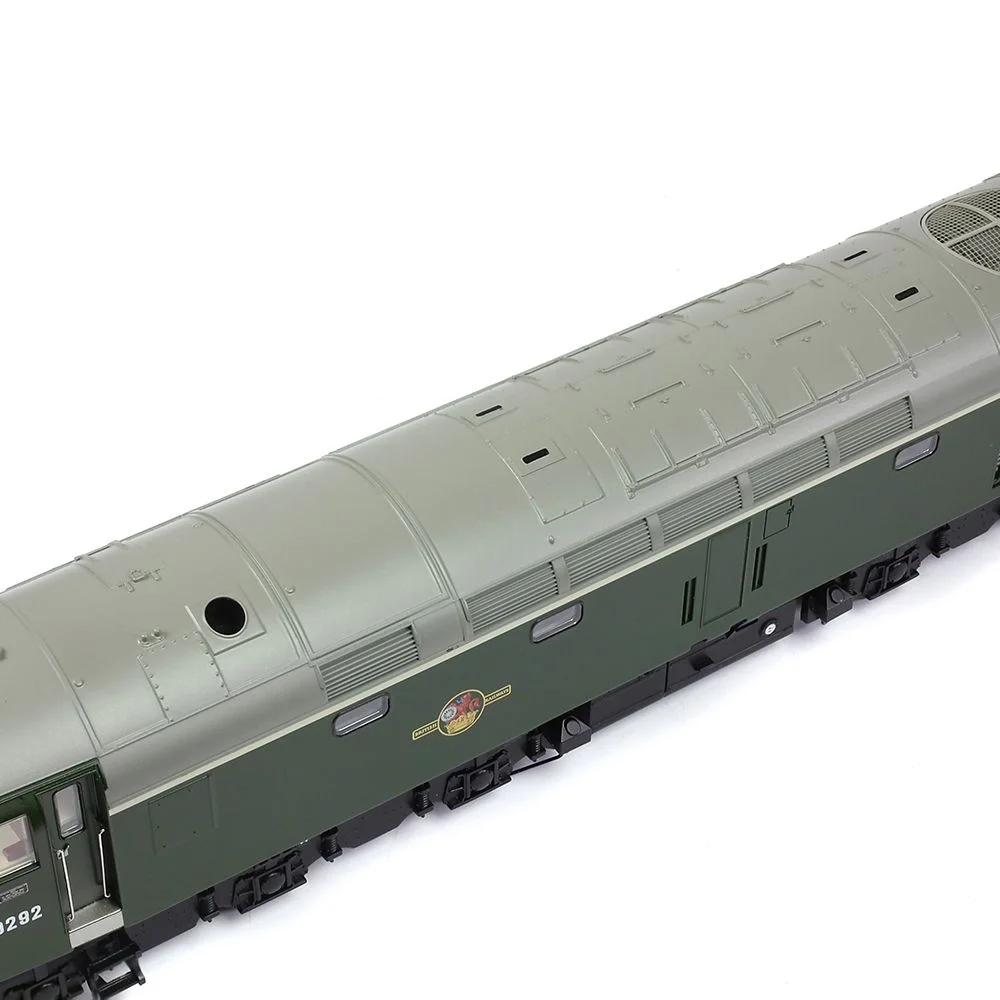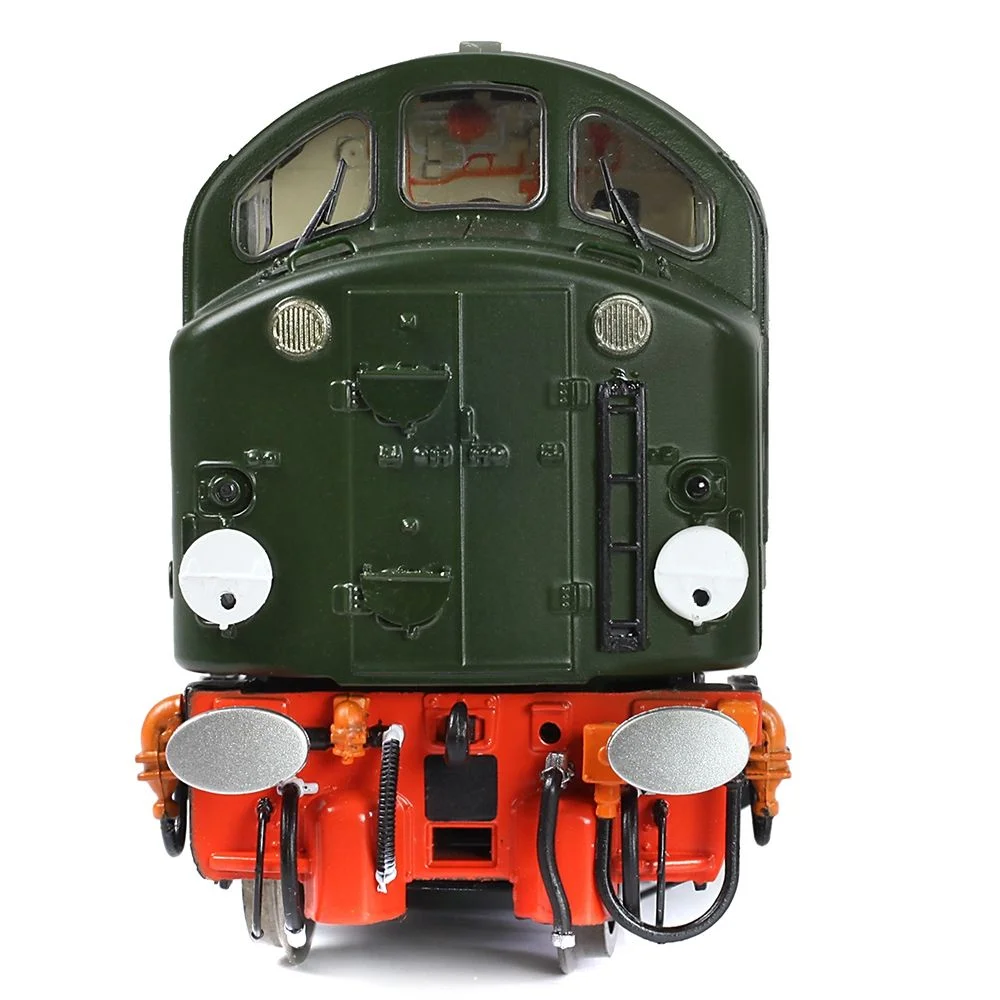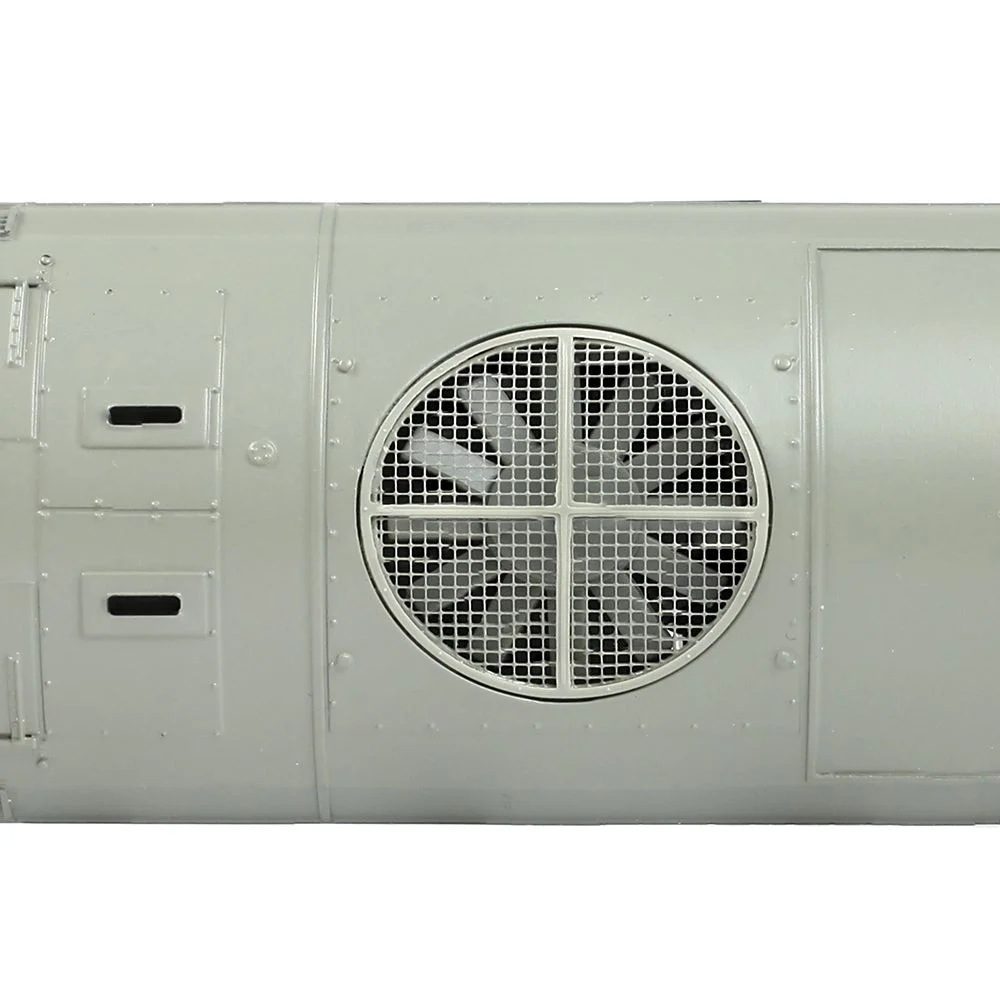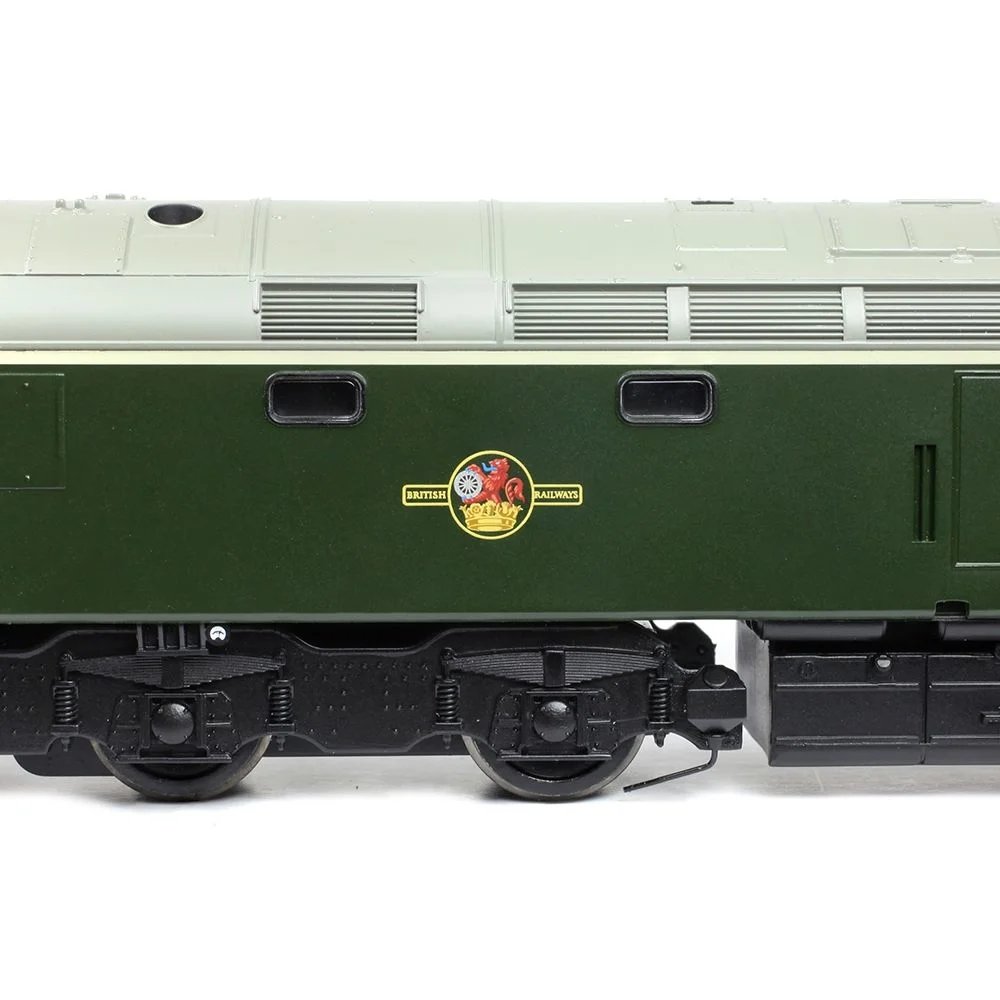Bachmann 32-488
British Rail Class 40 D292 British Railways Green with Late Crest
Tooling
In 2023, Bachmann launched a comprehensive upgrade of its OO gauge British Rail Class 40 model, introducing new tooling and advanced electronics to meet modern expectations for realism and digital control. This release built upon previous iterations with significant improvements in detailing, lighting, and sound, reaffirming the Class 40’s status as a flagship diesel model in the Branchline range.
Tooling Features
- Scale: OO gauge (1:76).
- Construction: Plastic bodyshell with extensive separately fitted details; diecast chassis for strength and weight.
- Detailing: Etched fan grilles, rotating radiator fan (non-powered), fine handrails, lamp irons, sandpipes, and bufferbeam pipework pre-fitted. Sprung buffers and fully detailed cab interiors with a pre-fitted driver in one cab. Variations in nose handrails, boiler fittings, and headcode styles accurately reproduced.
- Couplings: NEM362 pockets with tension-lock couplers.
Mechanical & Electrical
- Motor & Drive: Five-pole, twin-shaft motor with twin flywheels driving all six axles via authentic 1Co-Co1 arrangement.
- Pickups: Electrical pickup from all twelve driving wheels; separate metal bearings on driven axles for smooth running.
- Minimum Radius: Second radius curves (approx. 438mm).
- Lighting: Directional headlights and tail lights, high-intensity headlights where applicable, and cab lighting. All lighting functions are independently switchable under DCC.
- Weighting: Substantial diecast chassis for excellent traction and haulage.
DCC Capability
DCC Ready with a PluX22 socket. All models include twin speaker provision, and SOUND FITTED versions feature ESU LokSound V5 decoders with exclusive sound profiles recorded from real locomotives. Sound-fitted models operate on both DCC and analogue layouts, playing authentic start-up and running sounds when power is applied.
Liveries Produced
- BR Green (early and late crest, variations with small yellow panels and full yellow ends).
- BR Blue (standard and Scottish Region variants with centre headcode boxes).
- Preservation-era schemes, including BR large logo blue (e.g., 40145).
Headcode options include disc headcodes, split boxes, and centre headcode panels, with tooling variations for Scottish Region locomotives.
Reviews & Commentary
The 2023 upgrade received strong praise for its enhanced detailing, refined tooling, and advanced electronics. Reviewers highlighted the improved lighting functions, twin speaker setup, and smooth, powerful performance. The ESU sound implementation was generally well-regarded, though some enthusiasts suggested aftermarket sound profiles for greater authenticity. Overall, the model was considered a benchmark for British diesel modelling in the 2020s.
Media & Social Media
Coverage in Hornby Magazine, Key Model World, and YouTube reviews showcased the model’s features and sound capabilities. Social media discussions praised the upgrade for its accuracy and operational quality, with some debate around sound file preferences and speaker upgrades.
Interesting Notes
This tooling introduced PluX22 connectivity, advanced lighting control, and factory-fitted sound options as standard for many variants. It remains the most feature-rich Class 40 model produced by Bachmann to date.
Bachmann's Description & Specifications
The Class 40 Diesel Locomotive has long been a highlight of the Bachmann Branchline OO scale fleet, and for 2023 this popular model has been upgraded to bring you more features than ever before.
With the DCC decoder interface upgraded to Plux22; new lighting features and enhanced speaker arrangements have also been employed on the Class 40 to enhance the operating experience. On track the model has a mighty presence, just like the real locomotives and, with its five pole, twin flywheel motor powering all six driving wheels, you can be sure of a performance to match too. This Class 40’s good looks are enriched by the superb livery application using true-to-prototype colours, fonts and logos to produce a model fit for any collection.
Finished in original BR Green condition with Disc Headcodes, we are pleased to present No. D292.
- Bachmann Branchline OO Scale
- Era 5
- Pristine BR Green (Late Crest) livery
- Running No. D292
- Equipped with a Plux22 DCC Decoder Socket – recommended Decoder item No. 36-570A
- Length 285mm
DETAIL VARIATIONS SPECIFIC TO THIS MODEL
- Disc Headcodes (Discs supplied in the Accessory Pack)
- Nose-Top Handrails
- Clayton Boiler Port on Roof (with optional blank supplied in the Accessory Pack)
- Cantrail Grilles Arranged as appropriate to a locomotive with a Clayton Boiler
- Square Boiler Access Panel
- Fitted with Multiple Working Equipment
- Etched Frost Grilles (optional part supplied in the Accessory Pack)
BACHMANN BRANCHLINE CLASS 40 SPECIFICATION
MECHANISM:
- Five pole, twin shaft motor with two flywheels providing drive to both bogies
- Authentic 1Co-Co1 drive arrangement with six axle drive
- Electrical pickup from all twelve driving wheels
- Separate metal bearings fitted to each driven axle
- Gearing arranged for prototypical running speeds and haulage capabilities
- 16.5mm (OO gauge) wheels to NEM310 & NEM311 standards with authentic profile and detailing
- NEM coupling pockets to NEM362 standards integrated into each bogie
- Designed to operate on curves of second radius (438mm) or greater
DETAILING:
- Bogies fitted with separate steps and sandboxes
- Rotating radiator fan (un-motorised)
- Separately applied metal detail parts, including grab handles, sand pipes and etched fan grilles
- Sprung buffers
- Pre-fitted driver in one cab
- Each model is pre-fitted with a full set of decorated, model-specific buffer beam pipework and accessory parts
LIGHTING:
- Directional lighting, including headlights and high intensity headlights where applicable, switchable on/off at either end on DCC or Analogue control
- Cab lighting*, assigned to two DCC functions for separate switching of each
- Authentic light colours and temperatures selected for each model based on era and application
DCC:
- Plux22 DCC decoder interface
SOUND:
- Two quality speakers employed for optimum sound reproduction, fitted to every model as standard
- ESU Loksound V5DCC Sound Decoder fitted to SOUND FITTED versions
- Sound files produced specifically for the Bachmann Branchline Class 40 using recordings from real locomotives
- SOUND FITTED models operate on DCC and Analogue control as supplied. On Analogue, an authentic engine start up sequence and running sounds are produced when power is applied
LIVERY APPLICATION:
- Authentic liveries applied to all models
- Multiple paint applications employed on each model using BR and corporate specification colours
- Logos, numerals and text added as appropriate using multi-stage tampo printing using authentic typefaces, logos and colours
- In addition, where applicable Etched Nameplates and Plaques are also provided
Class & Prototype
- Class: British Rail Class 40
- Traction: Diesel
- Transmission: Electric
- Built: 1958-1962
- Total Built: 200
- Running Number: D292
- Ordered By: British Railways
- Built By: English Electric
- Built At: Vulcan Foundry
- Built: 09/1960
- Withdrawn: 12/1982
- Length of Service: 22.3 years
- Running Numbers: BR D292, BR 40092
- Names: -
British Rail Class 40 "Whistlers" were iconic diesel-electric locomotives that pioneered Britain's transition from steam to diesel traction between 1958-1985. Built by English Electric with distinctive turbocharger whistles and 2000hp engines, these 200 locomotives initially worked prestigious services like the Flying Scotsman before settling into secondary passenger and freight duties. Their conservative engineering prioritized reliability over power, leading to eventual displacement by more capable designs. Seven locomotives survive in preservation, while excellent model representations from Bachmann, Graham Farish, and Heljan serve railway modellers across all scales. The class remains beloved for its pioneering role, distinctive sound, and elegant styling that defined the early diesel era.
D292/40092 was built at English Electric's Vulcan Foundry in Newton-le-Willows and entered traffic on September 5, 1960, initially allocated to Crewe North depot (5A). The locomotive spent its entire 22-year career on the London Midland Region, representing a typical operational life for the class.
Notable service highlights include working the prestigious "Royal Scot" express service at Preston in the early 1960s, demonstrating its initial deployment on premier passenger duties. The locomotive was photographed at various locations including Crewe diesel depot in 1969 alongside sister locomotive D210 "Empress of Britain," and was observed working parcels trains at York in 1975.
By its final years, 40092 had been transferred to Healey Mills depot in Yorkshire, reflecting the class's gradual relegation from express passenger to secondary freight duties. The locomotive appeared at a BR/Steamport exhibition at Southport on September 11, 1982, having been specially prepared for display—one of its final public appearances.
40092 was withdrawn from service on December 5, 1982, and subsequently scrapped at Swindon Works on March 1, 1986. The locomotive's career spanned the complete evolution of the Class 40 fleet from prestigious express passenger service to final withdrawal, making it representative of the class's operational history and ultimate fate when displaced by more modern traction.
Operator & Livery
- Operator: British Railways
- Livery: Green with Late Crest
- Era: 5 - British Railways Late Crest
British Railways transformed Britain's fragmented rail network into a unified national system following nationalisation on 1st January 1948. Created from the "Big Four" companies under the Transport Act 1947, BR operated most of Great Britain's railways until rebranding as British Rail in 1965, managing over 20,000 route miles and inheriting nearly 20,000 locomotives of diverse designs.
The organisation pioneered standardisation through its revolutionary BR Standard locomotive programme (1951-1960), producing 999 advanced steam engines under Robert Riddles' direction. These included the versatile Britannia Pacifics, mighty 9F freight engines, and mixed-traffic classes that incorporated the best features from all predecessor companies. The 1955 Modernisation Plan accelerated diesel and electric traction development, creating fascinating mixed-traction operations.
Notable achievements included establishing unified locomotive classification systems, introducing distinctive corporate liveries, and managing the complex transition from steam to modern traction. BR's six regional structure preserved operational diversity whilst enabling standardisation of practices, signalling, and rolling stock that had eluded private enterprise for over a century.
The BR era represents steam traction's final flowering alongside emerging diesel technology, creating unparalleled locomotive variety. Today, this heritage remains highly popular with railway enthusiasts through extensive preserved fleets, heritage railway operations, and comprehensive model ranges from manufacturers like Hornby, Bachmann, and Dapol, making BR subjects essential for authentic post-war British railway modelling across all scales.

